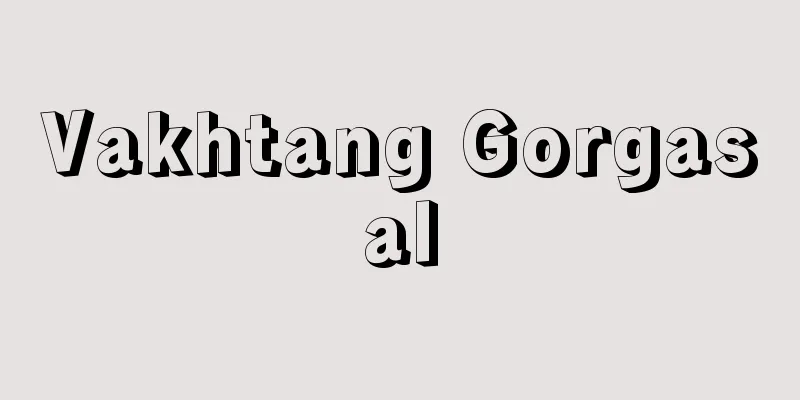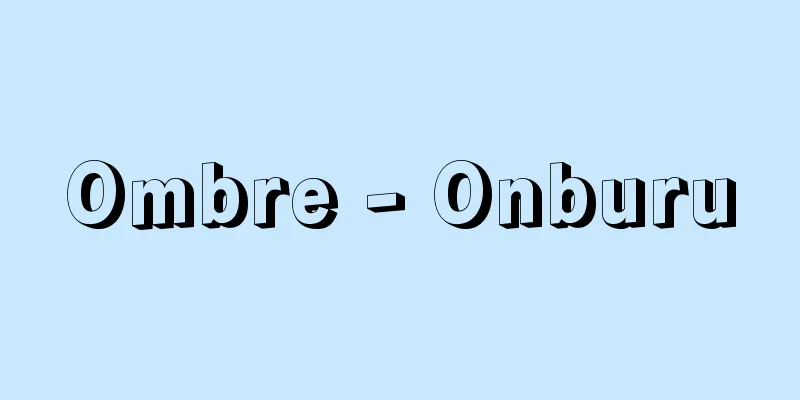German Art

Germanic AntiquesIt is said that the Germanic people were originally a people who did not place much value on visual reproduction. Looking at existing Germanic ancient art, we can see that it is decorated with "braided cord patterns" that are patterns of animal designs brought by prehistoric nomads, and its magical labyrinthine world speaks of the magical and emotional feelings of this people who went through a period of great migration. In "The Knight's Stone of Hornhausen" (late 7th century, Halle Museum of Art), we can see the simple diagramming of the subject, the expressive symbolism, and the symbolic grasp of the essence, and we can see the distinctive mentality of this people, which is the opposite of the sensibility of the Latin people. [Taro Nomura] middle agesIt was Charlemagne (reigned 768-814) who first shed light on the Germanic peoples on a different culture. However, even during the Carolingian dynasty, which focused on the spread of Christianity and the promotion of ancient culture, German art in the strict sense had not yet been born; its establishment had to wait until the Ottonian dynasty about a century later. The St. Pantaleon Cathedral built in Cologne at that time was famous for its twin-towered facade, and St. Michael's Cathedral built by Bishop Bernwald of Hildesheim also became a model for later church architecture. The Bronze Door, named after Bernwald, shows the progress of the era in its spatial expression in high relief. Other fruits of this period include the manuscript illustrations of the Reichenau Abbey on Lake Constance and the metalwork of the Maas and Rhine rivers. Of particular note is Archbishop Gero's Crucifixion in Cologne Cathedral, a life-size wooden statue carved into the round, which displays his ingenuity in eliciting spiritual greatness from extreme physical pain and his brilliant sculptural thinking that sees ugliness as a form of artistic expression as well. German Romanesque focuses on the interior space of the cathedral. Its pioneering example, the Tomb of Archbishop Wettin (Magdeburg Cathedral), shows the ingenuity of typifying the great personality of the deceased. A striking example of this ingenuity is the Lion Statue in Braunschweig Square, the only freestanding outdoor sculpture of the time, a symbolic statue commissioned by Prince Henry the Lion (1125-1195) himself. The adoption of Gothic architecture in Germany was a gradual process. First, partial reconstructions that did not affect the Romanesque foundation were carried out, followed by extensions that preserved the space of the foundation (St. Elisabeth Church in Marburg, Church of Our Lady in Trier, Strasbourg Cathedral, etc.), and finally, in 1248, construction of Cologne Cathedral was started on the model of Amiens Cathedral. Later, with the development of Hallenkirche (hall-style churches), the idea of early Gothic sculpture, which borrowed the columns of churches for human figures, was not so strict in Germany, and many of the cathedral sculptures have a worldly feeling. Representative examples include "Ecclesia and Synagogue" (Strasbourg Cathedral), "Mary and Elisabeth" and "Knight Statue" (Bamberg Cathedral). In addition, the "Ekkehard and Uta Statue" by Meister at Naumburg Cathedral is known as an idealistic portrait sculpture. [Taro Nomura] RenaissanceThe 15th and 16th centuries in Germany were a time of turmoil due to the Protestant Reformation and the Peasants' War, but the new era was absorbed in Prague and other cities under the umbrella of the League of Cities, which were associated with Charles IV (reigned 1346-1379). The main form of aesthetic expression in this period was panel painting, and well-known schools include the Bohemian School, the Hamburg School, and the Cologne School led by Stephan Loehner (1410/1415-1451). Other notable artists include Hans Multscher (c. 1400-1467) from Swabia, Michael Pacher (c. 1435-1498) from South Tyrol, and Konrad Witz (c. 1400-1445) from Basel, as well as Stoss, Kraft, and Riemenschneider in engraving. Also noteworthy is the development of printmaking by the Hausbuchmeister and Schongauer. Following the strongly Gothic-influenced 15th century, the golden age of German painting began in the 16th century. Important artists include Dürer, who absorbed the Renaissance during two trips to Italy and achieved a fusion of North and South Europe, Grünewald, who is immortalized with the Isenheim Altarpiece, the Danube School's Altdorfer, Cranach the Elder, the painter of the Northern European Venus statue, Holbein the Younger, the portrait painter, and Baldung, the painter of chiaroscuro. [Taro Nomura] BaroqueThis period saw a remarkable development of decorative painting for architecture. The pioneer was the Mannerist Hans Rottenhammer (1564-1625), followed by Johann Michael Rottmayr (1654-1730), a representative of Austrian Baroque, and Asam (the elder brother), known as the "master of South German frescoes." However, the devastation caused by the Thirty Years' War (1618-1648) led to a long exodus of talented artists from the country after this period. These included Elsheimer in the 17th century, Mengs and Fuseli in the late 18th century, and others. Anton Graff (1736-1813), born in Switzerland and working in Dresden, displayed the realism of the Biedermeier style. [Taro Nomura] 19th centuryUnder the rule of the wise emperor Frederick II (1740-1786), Germany made great strides in the fields of philosophy, literature and music, but in the field of art, talent continued to flow out of the country, as seen in the Nazarenes who secluded themselves in the ruins of San Isidro in Rome. The leading figure who defended the solitary stronghold of German art during this period was the landscape painter Kaspar Friedrich. He was friends with the painter Phillip Otto Runge (1777-1810) and the poets Tieck and Novalis, and is remembered as a Romanticist painter who infused tragic emotion into the desolate landscapes of North Germany. In the second half of this century, the painter Menzel pioneered realism, while the painters Feuerbach and Marees showed an idealistic style, and the sculptor Hildebrand. Impressionism was introduced by Liebermann, but Art Nouveau (known as Jugendstil in Germany) also spread at about the same time, with Klimt in Vienna and Stuck in Munich being known as its painters. In the fields of architecture and crafts, the Deutscher Werkbund was formed in 1907. [Taro Nomura] 20th centuryThe 20th century, which included two world wars, was a time of unprecedented crisis for Germany, but it was also a time when Germany's creative spirit reached a heightened level comparable to that of the German Renaissance. Expressionism, inspired by the Norwegian painter Munch, played a part in the anti-naturalistic European avant-garde art movement of the early 20th century. The movement was founded by the Brücke (Bridge) in Dresden, Sturm (Storm) in Berlin, and Blaue Reiter (Blue Rider) in Munich, and its main painters included Kirchner, Nolde, Kokoschka, Marc, and Kandinsky, and the sculptor Barlach. Artists who were active in the Dada movement, which spread to Berlin, Hanover, and Cologne after World War I, and in the subsequent New Objectivity movement, include Grosz, Otto Dix (1891-1969), Kurt Schwitters (1887-1948), Ernst, and Arp. In addition, Klee, Kandinsky, Feininger, and Moholy-Nagy were invited to the Bauhaus, which was founded in Weimar in 1919 by architect Gropius, and pursued the synthesis of beauty and function. The above movements and the artists who participated in them were oppressed by the Nazis as "degenerate artists," and the flame of free art was extinguished. However, after World War II, it was revived by the activities of Baumeister and Schumacher, who responded to the international trend of Abstract Expressionism, and has produced various groups and artists who are contributing to the thought of contemporary art more actively than before the war. In particular, the achievements of Joseph Beuys (1921-1986), who pursued the idea of anti-art broadly beyond the boundaries of genres, Heinz Mack (1931- ) and Otto Piene (1928-2014) of the Zero Group, who opened up new horizons in the field of kinetic sculpture, and the neo-expressionist painter Georg Baselitz (1938- ), are particularly noteworthy. Other artists attracting international attention include the photorealist painter Gerhard Richter (1932- ), the fantasy painters Horst Janssen (1929-1995) and Paul Wunderlich (1927-2010), and the painter of human figures Horst Antes (1936- ). [Taro Nomura] "Maekawa Seiro (ed.), "World Art Series 18: German Art" (1962, Kodansha)" ▽ " Nomura Taro (ed.), "Primary Color World Art 6: The Trend of German Art" (1970, Shogakukan)" ▽ "Okano Heinrich Keiichi (ed.), "A Walk Through the History of German Art: Ancient Sculptures" (1992, Senshu University Press)" ▽ "The same author, "Ruins and Ancient Architecture" (1995, Senshu University Press)" [References] |1525-1527 Oil painting, Metropolitan Museum of Art Cranach's "Venus and Cupid" 1532 Oil painting (Collection of the Metropolitan Museum of Art ) Holbein the Younger: The Eras of Rotterdam 1825-1830 Oil painting, Metropolitan Museum of Art Friedrich "Two Men Gazing at the Moon" Source: Shogakukan Encyclopedia Nipponica About Encyclopedia Nipponica Information | Legend |
ゲルマン古美術ゲルマン民族はもともと視覚の再現像にさほどの価値を認めない民族だったといわれる。現存のゲルマン古美術を見ても、そこに施されているのは先史時代の遊牧民が伝えた動物意匠を文様化した「組紐(くみひも)文」で、その魔的な迷路の世界は民族大移動期を経てきたこの民族の呪術(じゅじゅつ)的、情念的な心情を物語っている。『ホルンハウゼンの騎士石』(7世紀末、ハレ州立美術館)には、対象の簡潔な図式化と表出力豊かな記号性、および象徴的な本質把握が認められ、ラテン民族の感覚性とは対蹠(たいしょ)的なこの民族の精神性が特徴的にうかがわれる。 [野村太郎] 中世ゲルマン民族に初めて異質な文化の光を投じたのは、カール大帝(在位768~814)であった。しかし、キリスト教の普及と古代文化の振興を軸とするカロリング朝にも、厳密な意味でのドイツ美術はまだ誕生せず、その成立は約1世紀後のオットー朝を待たねばならなかった。当時ケルンに造営された聖パンタレオン聖堂は双塔式正面で名高く、またヒルデスハイム司教ベルンバルトの建立した聖ミハエル聖堂も後世の教会建築の範となった。ベルンバルトの名を冠してよばれる『青銅扉』は、高浮彫りの空間表現に時代の進歩がうかがわれる。コンスタンツ湖上のライヒェナウ修道院の写本挿絵、マース川およびライン川流域の金属工芸もこの時期の収穫である。特筆すべきはケルン大聖堂の『大司教ゲロのキリスト磔刑(たっけい)像』で、木の丸彫りによる等身大のこの像には、肉体的苦痛の極限から精神の偉大さを導き出そうとする創意、醜もまた芸術的表現でありうるとする卓抜な造形思考が働いている。 ドイツ・ロマネスクは、むしろ聖堂の内部空間に視線が注がれている。その先駆的な作例『大僧正ウェッティンの墓碑』(マクデブルク大聖堂)には、故人の偉大な人格を典型化する創意が読み取れる。この創意の奇抜な作例はブラウンシュワイク広場の当代唯一の野外独立彫刻『ライオン像』であるが、これはハインリヒ獅子(しし)公(1125―1195)が自ら命じてつくらせた象徴像である。 ドイツにおけるゴシック建築の摂取は、時間をかけて段階的に行われた。最初はロマネスクの母胎に影響ない部分改築、ついで母胎の空間を保持した増築(マールブルクの聖エリザベート教会、トリアの聖母教会、ストラスブール大聖堂など)として行われ、最後にケルン大聖堂がアミアン大聖堂を範として造営に着手されたのは1248年である。その後ハルレンキルヘ(広間式教会堂)の発達もあって、聖堂の円柱を人間像のために借用する初期ゴシック彫刻の発想もドイツではあまり厳密ではなく、聖堂彫刻でありながら現世的な情感の漂うものが多い。代表的作例に『エクレシアとシナゴーグ』(ストラスブール大聖堂)、『マリアとエリザベツ』『騎士像』(バンベルク大聖堂)などがある。また、ナウムブルク大聖堂のマイスター作『エッケハルトとウタ像』は観念的肖像彫刻として知られる。 [野村太郎] ルネサンスドイツの15、16世紀は、宗教改革と農民戦争の混乱期であるが、カール4世(在位1346~1379)ゆかりのプラハおよび都市同盟傘下の諸都市で新時代の吸収が行われる。この時代の美的表現の主役は板絵で、「ボヘミア画派」「ハンブルク画派」、そしてロッホナーStephan Loehner(1410/1415―1451)を中心とする「ケルン画派」などが知られる。ほかに、シュワーベンのムルチャーHans Multscher(1400ころ―1467)、南チロール(ティロル)のパッハーMichael Pacher(1435ころ―1498)、バーゼルのウィッツKonrad Witz(1400ころ―1445ころ)、彫刻ではシュトス、クラフト、リーメンシュナイダーがいる。また、ハウスブーフのマイスターHausbuchmeisterやションガウアーによる版画の発達も特筆される。 ゴシックの色濃い15世紀に続いて、ドイツ絵画黄金の16世紀が始まる。重要な画家としては、二度のイタリア旅行でルネサンスを吸収し南北ヨーロッパの融合を果たしたデューラー、『イーゼンハイム祭壇画』一作で不滅の名を得ているグリューネワルト、ドナウ派のアルトドルファー、北ヨーロッパのビーナス像の画家クラナハ(大)、肖像画家ホルバイン(子)、明暗の画家バルドゥングの名があげられる。 [野村太郎] バロックこの時期には建築のための装飾画の発達が目覚ましい。マニエリスム的なロッテンハンマーHans Rottenhammer(1564―1625)を先駆者とし、オーストリア・バロックを代表するロットマイルJohann Michael Rottmayr(1654―1730)、「南ドイツのフレスコの巨匠」といわれたアサム(兄)の名があげられる。しかし三十年戦争(1618~1648)による荒廃は、この時期以後長く才能ある美術家の国外流出を招来した。17世紀のエルスハイマー、18世紀後半のメングス、フューゼリらがそれである。なお、スイス生まれでドレスデンで制作したグラッフAnton Graff(1736―1813)は、ビーダーマイアー様式のリアリズムをみせている。 [野村太郎] 19世紀名君フリードリヒ2世(在位1740~1786)以来、哲学、文学、音楽の各分野で躍進したドイツも、美術の分野では、ローマのサン・イシドロの廃寺にこもったナザレ派のように、なお才能の国外流出が続いた。この時期にドイツ美術の孤塁を守った第一人者は風景画家のカスパー・フリードリヒである。画家ルンゲPhillip Otto Runge(1777―1810)、詩人ティークおよびノバーリスらと親交のあった彼は、北ドイツの荒涼とした風景に悲劇的情感を盛ったロマン主義の画家として記憶される。この世紀の後半、現実主義を開拓した画家にメンツェル、理想主義的作風を示した画家にフォイエルバハとマレース、同じく彫刻家にヒルデブラントがいる。印象主義はリーバーマンによって移植されたが、ほぼ同時期にアール・ヌーボー(ドイツではユーゲントシュティル)も波及し、ウィーンのクリムト、ミュンヘンのシュトゥックがその画家として知られる。建築および工芸の分野では、1907年ドイツ工作連盟が組織された。 [野村太郎] 20世紀二つの世界大戦を含む20世紀は、ドイツにとって未曽有(みぞう)の危機的時代であるが、この時代にドイツの造形精神はドイツ・ルネサンス期にも比肩する高揚をみせた。ノルウェーの画家ムンクに鼓舞された表現主義は、反自然主義的な20世紀初頭のヨーロッパ前衛美術運動の一翼を担った。ドレスデンの「ブリュッケ(橋)」、ベルリンの「シュトゥルム(嵐(あらし))」、ミュンヘンの「ブラウエ・ライター(青騎士)」が運動の母体で、おもな画家にはキルヒナー、ノルデ、ココシュカ、マルク、カンディンスキーらがおり、彫刻家にはバルラッハの名があげられる。第一次世界大戦後にベルリン、ハノーバー、ケルンに波及したダダの運動、およびそれに続く新即物主義の思潮のなかで活躍した美術家にはグロッス、ディクスOtto Dix(1891―1969)、シュビッタースKurt Schwitters(1887―1948)、エルンスト、アルプらがいる。また、1919年に建築家グロピウスによってワイマールに設立された「バウハウス」には、クレー、カンディンスキー、ファイニンガー、モホリ・ナギらが招かれて、美と機能との総合を追求した。 以上の運動やそれに参加した美術家たちはナチスによって「退廃芸術家」として弾圧され、自由な芸術の火は消えた。しかし第二次世界大戦後、抽象表現主義の国際的な潮流に呼応するバウマイスターやシューマッハーの活躍で復興され、戦前にもまして活発に現代美術の思潮に寄与する諸グループや美術家たちを生んでいる。とくにジャンルの枠をこえて反芸術の理念を幅広く追求したボイスJoseph Beuys(1921―1986)、動く彫刻の分野に新生面をひらいたゼロ・グループのマックHeinz Mack(1931― )やピーネOtto Piene(1928―2014)、ネオ・エクスプレショニズム(新表現主義)の画家バーゼリッツGeorg Baselitz(1938― )らの活躍は特筆される。また写真リアリズムの画家リヒターGerhard Richter(1932― )、幻想の画家ヤンセンHorst Janssen(1929―1995)とブンダーリヒPaul Wunderlich(1927―2010)、人間像の画家アンテスHorst Antes(1936― )も国際的に注目されている。 [野村太郎] 『前川誠郎編著『世界美術大系18 ドイツ美術』(1962・講談社)』▽『野村太郎編著『原色世界の美術6 ドイツ美術の流れ』(1970・小学館)』▽『岡野Heinrich圭一著『ドイツ美術史散歩 古彫刻篇』(1992・専修大学出版局)』▽『同『遺跡・古建築篇』(1995・専修大学出版局)』 [参照項目] |1525年~1527年ころ 油彩メトロポリタン美術館所蔵"> クラナハ『ビーナスとクピド』 1532年ころ 油彩メトロポリタン美術館所蔵"> ホルバイン(子)『ロッテルダムのエラス… 1825~1830年ころ 油彩メトロポリタン美術館所蔵"> フリードリヒ『月を眺める二人の男』 出典 小学館 日本大百科全書(ニッポニカ)日本大百科全書(ニッポニカ)について 情報 | 凡例 |
<<: Evangelical Church in Germany - Evangelical Church in Germany
>>: German East Africa Company (English: Deutsch‐Ostafrikanische Gesellschaft)
Recommend
Orphan of the Cho family
A Chinese play from the Yuan dynasty. Four-volume...
Special tax measures - sozeitokubetsusochi
Based on policy perspectives such as economic pol...
Goyigama
...Under Portuguese rule in the 16th century, Chr...
Ligue Internationale pour l'Éducation nouvelle
…In 1898, French educational reformer JE Demolins...
Oken, L.
...Scientists also formed new academic societies ...
Bell Etoile (English spelling)
…There are about 40 known species of Philadelphus...
Kallinos (English spelling)
Greek elegiac poet of the 7th century BCE. Only a ...
Sinkhole
…Doline comes from the Serbian word dolina, which...
Macrozamia hopei (English spelling) Macrozamia hopei
… [Makoto Nishida]. … *Some of the terminology th...
Dyshidrosis - Hyperhidrosis
〘noun〙 A disease in which sweat contains odor, col...
"The Battle of Fujito" - Kaba no Kanja Fujito no Kassen
… [Toyotakeza era] In 1726, he collaborated with ...
Childerich III
?‐754 The last Frankish king of the Merovingian dy...
Pava (English spelling)
…an ancient tribe in northern India. Around the 6...
Channa maculata (English spelling)
...This species is also called snakehead in Engli...
Suzuki Makino - Suzuki Bokushi
A man of letters from the late Edo period. Born i...









